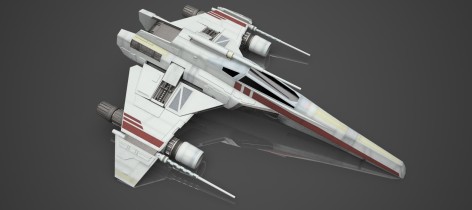As designed, the E-wing was intended to match, or exceed, the performance of the preceding X-wing series in nearly every respect, and was originally intended to replace the older design in New Republic service. However, the craft suffered from some significant problems when first deployed among front-line squadrons, including malfunction issues with the laser cannons and the new R7 astromech units. As a result, many pilots continued to fly upgraded versions of the venerable X-wing.
Despite the initial problems, improved models of the E-wing would see wide spread use by the New Republic, particularly by the Fifth Fleet, and later by the Galactic Alliance. They would play a significant role in every engagement from the Black Fleet Crisis, through the Yuuzhan Vong War, and beyond.
By the time of the Second Galactic Civil War, the E-wing had matured into an excellent starfighter design and equipped several elite squadrons of the Galactic Alliance. However, it never achieved the same popularity or wide spread use as the X-wing.
The E-wing was considered an excellent combination of firepower, maneuverability, speed, and armor, but initial models required the use of the R7-series astromech droid, which was exclusively built for the E-wing.
The spaceframe of the E-wing was surrounded by two aerodynamic foils which provided stability and increased weapons ability. The nosecone contained the starfighter's powerful sensors, while a concealed astromech droid could easily be positioned midway through the craft. Directly in front of the astromech slot was the cockpit.
The fighter was heavily armed with three laser cannons and one proton torpedo launcher with a magazine of sixteen torpedoes. Like most Rebel designs, the lasers were spread out and could be set to converge at varying distances.
A single E-wing cost 185,000 credits.
Much of the great cost of the E-wing came from the use of the R7 droid, a much more sophisticated and expensive astromech than the classic R2 and R5 astromechs. Later models of the E-wing starfighters were however able to interface with earlier astromech models, such as an R2 or R5 unit.
If you see errors or missing data in this entry, please feel free to log in and edit it. Anyone with a Gmail account can log in instantly.







